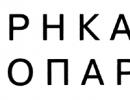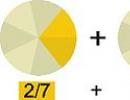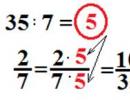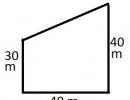Presentation - Culture of Kievan Rus in the X-XII centuries. Culture of Rus' X - XIII centuries. presentation for a history lesson (grade 10) on the topic Culture of Kievan Rus 12th-13th centuries presentation
Block width px
Copy this code and paste it onto your website
Slide captions:
Culture of Rus' in the XII-XIII centuries
“Oh, bright and beautifully decorated Russian land!
You are famous for many beauties...
You are filled with everything, Russian land...”
Features of culture of the XII-XIII centuries
Large cultural centers
Velikiy Novgorod
Vladimir-on-Prince
Distinctive features of cultural development
- Novgorod and Pskov- traits emerged that corresponded to the veche order and activity of the urban population.
- Vladimir-Suzdal land - example of splendor, solemnity, desire to emphasize the power and importance of the Vladimir princes .
- Townspeople engaged in trade, including with foreign countries.
- Merchants kept records of goods purchased and sold. They had to be able to write and count. They also brought information about life in other countries to Rus'.
- The highest literacy rate in Rus' was in Novgorod.
Boys and girls studied in schools. The main material for writing was birch bark.
+- To serve in the church, monks and clergy had to know how to read and write.
- The monks kept chronicles. They recorded not only the events of political life, but also recorded such natural phenomena as: eclipses, comets, storms, droughts, etc.
- Princes and boyars education was needed to know the laws, issue them and apply them correctly.
- In most Russian lands, schools existed in monasteries.
Accumulation of scientific knowledge
Merchants' travels
Pilgrimage
Recordkeeping
Military campaigns
Geography
Astronomy
Biology
Description of other countries and various natural phenomena
Description of comets, eclipses
Description of epidemics, diseases
Literature
New genres
Land features
Teaching
Walking
Novgorod-Seversk land
Vladimir-Suzdal land
"The Tale of Igor's Campaign"
"The Prayer of Daniel the Imprisoner"
Call for the unity of the Russian land in the face of an external threat
Reflections on an ideal ruler
Architecture
Novgorod land
Vladimir-Suzdal land
Modesty of decoration, small size of churches
The splendor of the decoration, the large size of the churches
Limestone, stone carving
Novgorod Church of St. St. George on Ladoga Church of the Savior on Nereditsa near Novgorod Vladimir Dmitrievsky Cathedral Temple of the Intercession on the Nerl Bogolyubov Monastery Assumption Cathedral Iconography
- Initially, icons in Rus' were painted by artists invited from Bulgaria and Byzantium.
- At the beginning of the 13th century, after the Polovtsian raids and the defeat of the Byzantine Empire by the crusaders, the influx of artists to Rus' ceased.
- The Russian school of icon painting arose. It differed from the Byzantine one in its brighter colors and humanized images of saints.
To use presentation previews, create a Google account and log in to it: https://accounts.google.com
Slide captions:
Culture of Rus' X - XIII centuries. The Origin of Russian Civilization
Plan Features of cultural development Writing, literacy, schools Chronicles Literature Architecture Painting, sculpture, music Folklore Everyday life The birth of Russian civilization
Features of cultural development The culture of the Eastern Slavs was both the culture of the pagan world with its ancient folk customs, beliefs, rituals, songs and dances, and the Christian culture with the powerful influence of the Church in the field of literature, architecture, art, writing, schooling, and libraries.
Writing, literacy, schools. Letters in Rus' were carved on wooden tablets and called them rezas. Later, birch bark (birch bark letters) began to be used as a material for writing. The Slavic alphabet, created by the brothers Cyril and Methodius, became widespread.
The Christianization of Rus' gave a powerful impetus to the development of writing and literacy. Scribes and translators came to Rus', and a flood of foreign books with religious and secular content poured in. This phenomenon became especially widespread under Yaroslav the Wise and his sons. Biography of Alexander the Great "Alexandria". Schools were initially opened at churches and monasteries. Later, girls were also taught in schools. Vladimir Monomakh's sister Yanka founded a convent in Kyiv with a school for girls attached to it.
Evidence of the development of literacy is also preserved on the walls - graffiti. On the wall of the St. Sophia Cathedral, Vladimir Monomakh once wrote: “Oh, it’s hard for me.”
Chronicles Chronicles - weather reports of important events in Rus'. artistic and historical works (the authors' views on the history of Rus' and world history, on the activities of princes, etc.) At the end of the 10th century, the first chronicle was created under Prince Vladimir. At the end of the 12th century - “The Tale of Bygone Years” by the monk of the Kiev-Pechersk Monastery Nestor.
Literature The general rise of Rus', the development of literacy and writing, and the emergence of educated people led to the birth and development of Old Russian literature. The first literary work is “The Sermon on Law and Grace” by Hilarion. In the second half of the 12th century - “Memory and Praise to Vladimir” by the monk Jacob. “The Legend of the Initial Spread of Christianity in Rus'” and “The Legend of Boris and Gleb.”
In the 12th century, the first memoirs appeared. “Teaching” by Vladimir Monomakh “Hegumen Daniel’s Walk to Holy Places” The highest achievement of ancient Russian literature is considered to be “The Tale of Igor’s Campaign” (12th century) - a story about the unsuccessful campaign of Prince Igor Svyatoslavich against the Polovtsians in 1185.
Architecture Wooden Rus'. With the advent of Christianity, stone and brick began to be used in construction. The architecture was characterized by intricacy, multi-tiered architecture, and the presence of turrets and towers in the buildings. With Christianity, the construction of large stone churches came to Rus'. They were like that
St. Sophia Cathedral in Kyiv
St. Sophia Cathedral in Novgorod
St. Sophia Cathedral in Polotsk
Spaso - Transfiguration Cathedral in Chernigov
Remarkable architectural structures were created during the collapse of Rus'. By order of Andrei Bogolyubsky, the Assumption Cathedral and the Golden Gate, the single-domed Church of the Intercession on the Nerl, were built in Vladimir. Under Vsevolod the Big Nest, St. Demetrius Cathedral was built in Vladimir. A characteristic feature of Russian architecture of this time was stone carving.
Painting, sculpture, music Ancient woodcarvers created sculptures of pagan gods and spirits. Painters painted the walls of pagan chapels and made magic masks. Pagan art was associated with the forces of nature. Christianity glorified God, the exploits of saints, apostles, and church leaders. Icons with stern faces of saints, mosaics and frescoes on religious themes appeared.
Works were created that followed folk traditions. Thus, the icons of the monk of the Kiev-Pechersk Monastery Alimpius resembled portraits of living people. Each principality developed its own trends in art. THE NOVGOROD SCHOOL OF ICON PAINTING WAS DIFFERENTIATED BY THE REALITY OF IMAGES. It appeared in the 13th century. Yaroslavl school of painting, whose artists recreated the faces of the Virgin Mary and saints on icons.
Fresco "The Last Judgment" in St. Demetrius Cathedral. Wood carvings, and later stone carvings, were used to decorate not only temples and homes, but also household utensils and dishes. Jewelers have achieved great skill. Earrings of Kievan Rus
Music was an integral part of Rus'. Singers, guslar players, masters of playing the lute and spiritual instruments, and dancers entertained both the nobility and the common people.
Caravaggio "The Lute Player"
Folklore An important element of ancient Russian culture was folklore - songs, legends, epics, proverbs, sayings, fairy tales. Ancient songs talked about how brides were kidnapped. The whole world of Russian life was revealed in epics. Their hero is a hero. Epics about Ilya Muromets, Dobrynya Nikitich, Alyosha Popovich
Everyday life The culture of a people is inextricably linked with its way of life, everyday life, and life was largely determined by the development of the country's economy. The houses were decorated with carpets and expensive Greek fabrics. The palaces and courtyards of the boyars were crowded with warriors, servants, and servants. Feasts were held in the court griddles. Women sat at the table equally with men. They distributed food and money to the poor and needy.
The favorite pastimes of rich people were falconry, hawk hunting and hound hunting. Races, tournaments, and various games were held. In the princely-boyar environment, at the age of three, a boy was put on a horse, then given to be trained by a pestun (educator). At the age of 12, young princes, together with prominent boyars, were sent to govern volosts and cities. Ordinary people lived in dugouts.
Traditional women's clothing were shirts (lower and upper). Their heads were covered with ubrus (shawls). Noble women also wore cloaks and caps over the headscarf. On long winter evenings, women spun yarn, men crafted.
The origin of Russian civilization (textbook pp. 118-120) What factors influenced the formation of Russian civilization? Which one do you think is the most important? What brings medieval Rus' closer to Western European civilization, what are the differences between them? Under the influence of what circumstances was the spiritual and moral image of the people formed? How have community traditions influenced the mentality of Russian people?
Description of the presentation by individual slides:
1 slide
Slide description:
History lesson in 6th grade on the topic CULTURE OF RUSSIAN LANDS in the XII - XIII centuries. Kaziev Kazim Zeinudinovich history teacher at the Druzhbinskaya Secondary School.
2 slide
Slide description:
1. Consider the cultural features of the Russian principalities. 2. Describe the main idea of literary creativity. 3. Introduce outstanding monuments of architecture and icon painting of the 12th-13th centuries. 4. Determine the influence of the Mongol invasion and Horde rule on Russian culture.
3 slide
Slide description:
1. Features of culture of the XII-XIII centuries. 2. Scientific knowledge. 3. Literature. 4. Architecture. 5. Painting. 6. The influence of Horde rule on Russian culture.
4 slide
Slide description:
Question: What impact, in your opinion, did fragmentation have on the cultural development of Russian lands? The separation of individual principalities not only did not stop the development of culture, but also contributed to its further flourishing. Each prince was interested in the development of his principality, in perpetuating his name. Local cultural centers have appeared - they develop their own cultural traditions. Large cultural centers of the 12th-13th centuries - NOVGOROD, PSKOV, VLADIMIR, GALICH.
5 slide
Slide description:
Novgorod, Pskov - features that correspond to the spirit of the veche order and the high activity of the urban population. The Vladimir-Suzdal Principality is an example of solemnity and splendor, emphasizing the power and importance of the Vladimir princes. Despite the diversity of local schools, styles, and traditions, ancient Russian culture continued to remain unified in its system. The most advanced monuments of art and literature of Ancient Rus' were created during this period.
6 slide
Slide description:
Translated church literature continued to occupy a large place. But there is an accumulation of factual material and elements of scientific knowledge necessary for the future development of science. Facts indicating the accumulation of scientific knowledge: they begin to translate works containing ideas about the universe, information on geography, botany, zoology, medicine, and world history; application in agriculture, handicraft production, architecture, painting of information on mathematics, mechanics, astronomy, geography; enriching the geographical knowledge of Russian people (trade relations, military campaigns, travel); the appearance of healers - lechtsi (healers). The most famous healer, monk of the Kiev Pechersk Monastery, AGAPIT.
Slide 7
Slide description:
Before the collapse of the state and before the Mongol invasion, literature followed the directions that were established under Yaroslav and his descendants. Since the 12th century, a new period in the history of Russian chronicles begins: Chronicles are kept in every major principality. Chroniclers focus on local events, viewing the history of their lands as a continuation of the history of the Russian state. Family princely chronicles and biographies of individual princes appear. Their compilers were boyars, warriors, and princes. This strengthened the secular direction in chronicle writing.
8 slide
Slide description:
Legends and epics created during the years of fragmentation became an expression of the people's desire for unity. New genres of literature are emerging: TEACHINGS - Vladimir Monomakh “Teachings for Children” is a favorite work of the Russian people of the early Middle Ages, the central idea is strengthening the unity of the Old Russian state. THE WORD - works that raise issues related to princely power; author Daniil Zatochnik “WORD” (“PRAYER”). A number of researchers believe that this work is an example of humorous literature of the 12th century - this is the composition of a pleading message, a laudable and at the same time accusatory word. “THE WORD ABOUT IGOR'S CAMPAIGN”, an outstanding work of ancient Russian poetry (XII century), testifying to the high level of culture, national consciousness and patriotism of the Russian people of that era.
Slide 9
Slide description:
... Truly, my children, understand that God, who loves mankind, is merciful and merciful. We humans are sinners and mortals, and if someone does evil to us, we want to devour him and shed his blood as quickly as possible. And our Lord, possessing both life and death, endures our sins above our heads throughout our lives. Just as a father, loving his child, beats him and again draws him to himself, so our Lord showed us victory over our enemies, how to get rid of them and defeat them with three good deeds: repentance, tears and almsgiving. And this, my children, is not a heavy commandment from God, how to get rid of your sins and not lose the kingdom of heaven by doing these three things. For God’s sake, don’t be lazy, I pray you, don’t forget those three things, they’re not hard. Neither seclusion, nor monasticism, nor fasting, which other virtuous people endure, but in small deeds one can receive God’s mercy. “What is a person, how do you think about him?” “Great are You, O Lord, and wonderful are Your works. The human mind cannot comprehend Your wonders,” and again we say: “Great are You, O Lord, and Wonderful are Your works, and blessed and glorious is Your name forever throughout all the earth.”
10 slide
Slide description:
A private episode of the Russian-Polovtsian wars was transformed into an event of an all-Russian scale, which gave a monumental sound to the main idea - a call to the princes to stop strife and unite in the face of an external enemy. Combining book and folklore traditions, the unknown author created a unique work of the lyric-epic genre; As the author, the researchers assumed the Galician scribe Timofey, the “verbal singer” Mitus, the son of the thousand-man Raguil, Kochkar, the “merciful man” Svyatoslav of Kyiv, the Kyiv thousand-man Peter Borislavich and Prince Igor himself (V. Chivilikhin). The manuscript of "The Lay" was discovered in the Transfiguration Monastery (Yaroslavl) by one of the most famous and successful collectors of written and material monuments of Russian antiquity - Count A.I. Musin-Pushkin (1744-1817+). The original manuscript of the Lay was lost in the Moscow fire of 1812, which gave skeptics reason to doubt the authenticity of the work. Thanks to the efforts of scientists for almost two hundred years, the original text of the monument has been almost restored and carefully commented on.
11 slide
Slide description:
Architecture of the XII-XIII centuries. differs from the previous period by reducing the volume and simplifying the appearance of stone buildings. The interiors became clearer and almost square and strictly subordinated to the central domed space. The most typical was a cubic temple with a massive dome. Many Russian lands, having their own builders, still continued the Kyiv architectural tradition. While maintaining the general features of architecture in different centers of Rus', its local features were developed.
12 slide
Slide description:
VLADIMIRO-SUZDAL PHINICIPALITY OF BOGOLYUBOV - the first stone city of Northern Rus', the residence of Prince Andrei Bogolyubsky, who ruled in 1157-1174. Bogolyubovo was built by order of Andrei Bogolyubsky. In the Laurentian Chronicle the castle bears the name Bogolyuboe, hence Prince Bogolyubsky. The foundation of Bogolyubov was associated with the legend of the appearance of the Mother of God to Prince Andrei. After the death of Prince Andrei in 1177, Bogolyubovo was ravaged and plundered by the Ryazan prince Gleb, and during the Tatar invasion in the 1230s the fortifications were destroyed.
Slide 13
Slide description:
After the death of Prince Andrei in 1177, Bogolyubovo was ravaged and plundered by the Ryazan prince Gleb, and during the Tatar invasion in the 1230s the fortifications were destroyed. The earthen ramparts, ditches and lower parts of the walls and pillars of the white stone fortifications have been partially preserved. Part of the northern wall with the transition of semicircular arches to the staircase tower, where Prince Andrei Bogolyubsky was killed on the June night of 1174, has survived. The Palace Cathedral of the Bogolyubsky Castle. To the left is the staircase tower. 12th century
Slide 14
Slide description:
Bogolyubovo Cathedral of the Nativity The main shrine of the Cathedral of the Nativity of the Theotokos was the icon of the Bogolyubovo Mother of God (12th century). On September 21, 1164, the greatest shrine of Rus' - the Miraculous Icon of the Mother of God - was transferred to the Assumption Cathedral, for which it was, in fact, built. Since then, the image began to be called the Vladimir Icon of the Mother of God.
15 slide
Slide description:
Assumption Cathedral, Cathedral of the Assumption of the Blessed Virgin Mary. A world-famous monument of ancient Russian architecture. The cathedral is a complex of buildings from different periods. Height – 32 meters. The cathedral was originally built in 1158-1161 under Prince Andrei Bogolyubsky on the high bank of the Klyazma in the city center and was conceived not only as the main temple of the Vladimir-Suzdal principality, its cultural, political and religious center, but also as the main temple of all Rus'.
16 slide
Slide description:
The chronicler reports that: “God brought craftsmen from all lands to Vladimir,” including foreign masters of white stone technology from the Romanesque West. This was a demonstration of the rejection of Kyiv assistance and artistic traditions. White stone for the construction of the cathedral was brought from Volga Bulgaria. In 1161, the walls were painted with skillful Greek isographs.
Slide 17
Slide description:
18 slide
Slide description:
Slide 19
Slide description:
After the fire of 1185, under Prince Vsevolod III, the cathedral was reconstructed. The old temple ended up inside buildings built from the south, north and west. As a result of the restructuring, by the 13th century the cathedral became vast, five-domed, with a gilded central dome and silver-plated side domes, and its top received two tiers of zakomaras. The cathedral is made of white stone. Inside, its walls, vaults and pylons are covered with fresco paintings.
20 slide
Slide description:
21 slides
Slide description:
After the death of Andrei Bogolyubsky, the castle town was empty. In Soviet times, Bogolyubovo became a branch of the Vladimir-Suzdal Historical, Artistic and Architectural Museum-Reserve. 1.5 km from Bogolyubov is the Church of the Intercession on the Nerl (1165).
22 slide
Slide description:
The best structure of Vladimir-Suzdal architecture from the era of Andrei Bogolyubsky that has come down to us is the Church of the Intercession on the Nerl, built in 1165. The church was dedicated to the holiday - the Intercession of the Mother of God. The Church of the Intercession is full of peace and purity. It is elegant, light and harmonious. The church stands alone on the banks of the Nerl. In the spring, when the waters of the river rise, the building is captured by the river. This was taken into account by the builders. The construction hill was reinforced with a complex foundation and lined with white stone slabs. The Church of the Intercession on the Nerl is called a masterpiece of world architecture.
Slide 23
Slide description:
24 slide
Slide description:
25 slide
Slide description:
The most interesting creation of the era of Vsevolod the Big Nest is the Demetrius Cathedral, dedicated to the holy warrior Dmitry of Thessalonica. The cathedral was founded in 1194. Compared to the Assumption Cathedral, Demetrius Cathedral is small, but very elegant and solemn. The walls of the cathedral are covered with sculptural decorations, making the temple seem openwork. This is the first time in Russian architecture that such abundant sculptural decoration has been found. On each facade, the center of the composition is King Solomon. Around it are grouped images of plants, animals, birds, and griffins. The cathedral has preserved some of the 12th-century paintings, including fragments of the composition “The Last Judgment.”
26 slide
Slide description:
Slide 27
Slide description:
Novgorod feudal republic. Almost all Novgorod churches were built at the expense of boyars, merchants and parishioners. Simplification of technology made it possible to create structures in a short time that corresponded to the material capabilities and aesthetic ideas of customers. By the beginning of the 13th century, a type of temple of a simple form had developed in Novgorod. In the ancient city of Ladoga in the north of the Novgorod Republic, the Church of St. George was built
28 slide
Slide description:
In the 12th century, an outstanding monument was built in the vicinity of Novgorod - the Church of the Savior on Nereditsa.
Slide 29
Slide description:
30 slide
Slide description:
Painting is mainly of a religious nature, but everyday subjects began to be present more often in church art. Through the strict Byzantine academicism, the features of folk art are visible. By the beginning of the 12th century, mosaic was replaced by fresco. The frescoes are bright, colorful, they often depicted real events and human images. On the icons, the saints looked very much like the princes who ordered them. The faces of the saints showed less asceticism and severity; they acquired characteristic Slavic features
31 slides
Slide description:
Frescoes of the Savior on the Nereditsa Church near Novgorod. 1199. Introduction to the Temple, Presentation.
32 slide
Slide description:
Yaroslav Vsevolodovich. Fresco of the Church of the Savior on Nereditsa church near Novgorod. Around 1246.
Slide 33
Slide description:
Slide 34
summary of other presentations“Achievements of the culture of Ancient Rus'” - Oral folk art. Foundation of Kyiv. What is it about. Gospel. Oleg. Writing and literacy. Culture of Ancient Rus'. Russian stone architecture. Test. Murder of Prince Igor. Handwritten books. Architecture. Nestor.
“Life in Rus'” - Funeral services, weddings, and baptisms were usually celebrated by the entire village. The location of the stove determined the layout of the hut. Povalusha was the name of the cold storage room of the dwelling. Later, the upper room began to be called the best room in Russian houses. The corner opposite the mouth of the stove was considered the housewife's workplace. Entertainment remained the same - gatherings, fortune telling, round dances. The peasant dwelling also had a lot of wicker utensils - baskets, baskets, and boxes.
“Culture of Rus' 10-13 centuries” - Yaroslav the Wise. Cathedral Church of Sofia. A film about this issue. So here we go. Development of chronicles. Answer to the question. Give a brief information about the cathedral. Painting. Monk Nestor. Team presentation. Golden Gate in Vladimir. Film on the theme "Literature". Architecture. The power of the city. Make up a word. Parchment. Nestor. Film on the theme "Painting". Culture of Rus' X-XIII centuries. Kyiv. The significance of these saints for history.
“Ancient cities of Rus'” - Private houses. Ancient plan of the Moscow Kremlin. New tasks - administrative, cultural and military. Development of ancient Russian cities. The presence of a fortification or fortification. Attempts to Europeanize Moscow. The guards must resist the fire. The city of Vladimir and Yaroslav. The emergence of cities of such scale as Novgorod and Kyiv. Architecture and everyday life of an ancient Russian city.
“Cultural Monuments of Ancient Rus'” - St. Sophia Cathedral. From the Varangians to the Greeks. Treaty of Prince Oleg with Byzantium. Acceptance of Christianity. Volga trade route. Culture of Ancient Rus' in the 9th-13th centuries. Angel Golden Hair. Polotsk Writing. Byzantine coins. Culture of Kievan Rus. Tithe Church. Boris and Gleb Monastery. Kyiv. Kiev-Pechersk Monastery. Russia's adoption of Christianity.
“Culture of Volga Bulgaria” - Science. Theologians and philosophers. Astronomy. Geography. Writing. Poets and writers. Medicine. Science and culture of Volga Bulgaria. Scientists are historians. Scientists of Volga Bulgaria. Literature written on paper. Chemistry. Notes from an Arabic author. Education.






